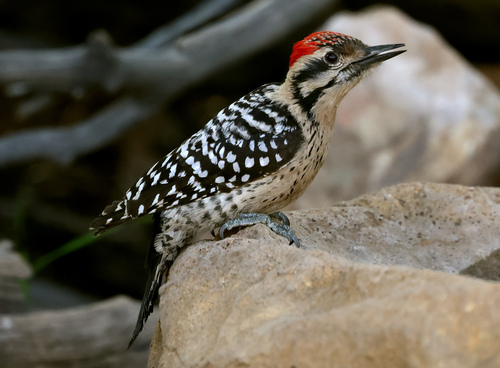
Ladder-backed Woodpecker
The Ladder-backed Woodpecker (*Dryobates scalaris*) is a small, resilient woodpecker species found in arid and semi-arid regions of North and Central America. Known for its distinctive black-and-white barred back, resembling a ladder, this bird plays a crucial role in its ecosystem by controlling insect populations. It is also culturally significant in some regions, symbolizing persistence and resourcefulness due to its ability to thrive in harsh environments.
16.5-19 cm
Length
28-33 cm
Wingspan
Least Concern
Conservation Status
Distribution
Southwestern United States (California, Arizona, New Mexico, Texas) through Mexico and into parts of Central America (Belize, Guatemala, Honduras, Nicaragua). Generally non-migratory, though some populations may exhibit short-distance altitudinal movements.
Lifespan
Typical lifespan in the wild is 4-5 years, though some individuals may live longer.
Ladder-backed Woodpecker's Habitat
Habitat Types
Desert scrub, Arid woodlands, Riparian corridors, Mesquite bosques, Oak savannas
Climate Zones
Arid, Semi-arid, Subtropical
Adaptations
Strong beak and skull for excavating in tough desert vegetation. Zygodactyl feet (two toes forward, two toes backward) for secure grip on vertical surfaces. Tolerance for high temperatures and limited water availability.
Variations
Several subspecies are recognized, differing slightly in size and plumage darkness depending on geographic location. For example, populations in Baja California tend to be paler.
Appearance
Breeding Plumage
Minimal seasonal variation. Males have a red crown patch, while females have a black crown patch.
Seasonal Feather Changes
None
Sex Based Plumage Differences
Males have a red crown; females have a black crown. Both sexes have the characteristic black-and-white barred back.
Notable Features
Black-and-white barred back (ladder-like pattern), Red crown patch (males only), White underparts with black spotting, Strong, chisel-like bill
Diet and Feeding
Primary Foods
Insects, Larvae, Beetles, Ants, Cactus fruit, Seeds
Foraging Behavior
Forages by pecking, probing, and gleaning insects from tree trunks, branches, and cacti. Often seen hammering on wood to excavate insects. Will also forage on the ground.
Specializations
Strong, sharp bill for excavating wood. Long, barbed tongue for extracting insects from crevices.
Seasonal Diet Variations
Diet may shift slightly depending on insect availability. May consume more cactus fruit and seeds during periods of insect scarcity.
Behavior
Social Structure
Generally solitary or found in pairs. May form small family groups after breeding.
Communication
Rapid drumming, Sharp 'pik' calls, Rattling calls, Visual displays (head bobbing, crest raising)
Migration
Mostly non-migratory, but some populations may move short distances in response to food availability or weather.
Territorial or Group Behaviors
Territorial during breeding season, defending nesting and foraging areas. Males are particularly aggressive in defending territories.
Conservation
Threats
Habitat loss (due to urbanization and agriculture), Competition with introduced species (e.g., European Starlings), Pesticide use (reducing insect prey)
Protection Programs
Habitat preservation efforts (e.g., protection of riparian areas), Nest box programs (in some areas)
Local National Laws
Protected under the Migratory Bird Treaty Act in the United States.
Population Trend
Stable
Population Estimates
Global population estimated to be around 2.6 million individuals.
Interesting Facts
They can withstand the extreme temperatures of desert environments.
Their physiology and behavior are adapted to conserve water and tolerate heat.
They often reuse nest cavities.
Suitable nesting sites can be limited in desert habitats.
Their drumming serves as a form of communication.
Used to establish territory and attract mates.
Faqs about Ladder-backed Woodpecker
What is the difference between a male and female Ladder-backed Woodpecker?
Males have a red crown patch, while females have a black crown patch.
What do Ladder-backed Woodpeckers eat?
Primarily insects and larvae, but also cactus fruit and seeds.
Are Ladder-backed Woodpeckers endangered?
No, they are classified as Least Concern by the IUCN.
Where do Ladder-backed Woodpeckers build their nests?
They excavate cavities in trees, cacti, or even utility poles.
Copyright @ Nature Style Limited. All Rights Reserved.
 English
English